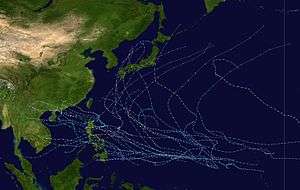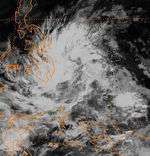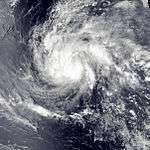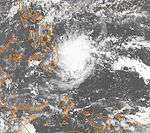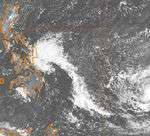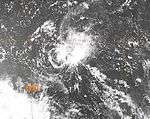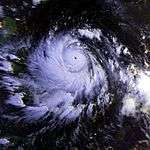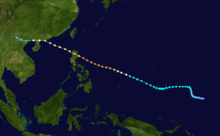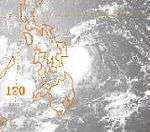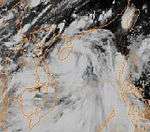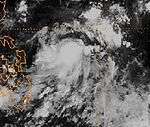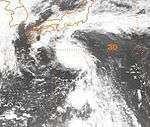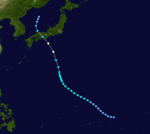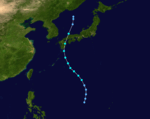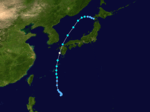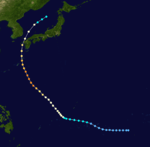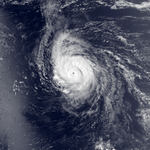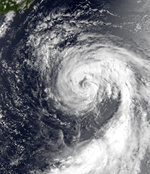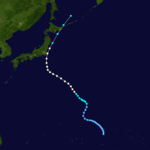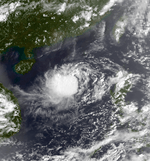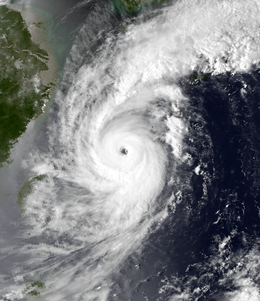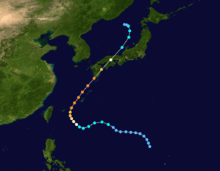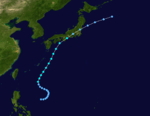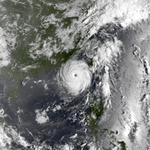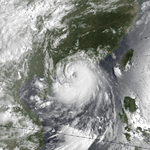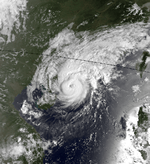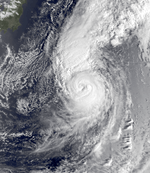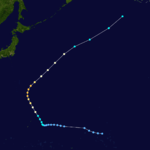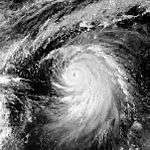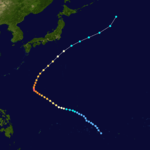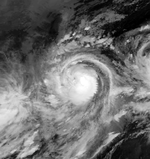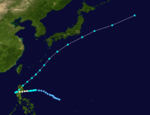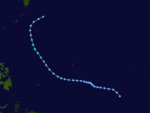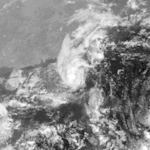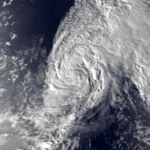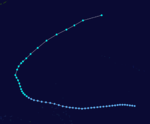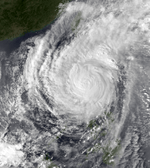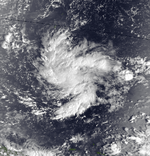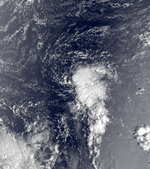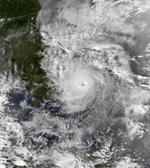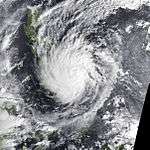1993 Pacific typhoon season
| |
| Season summary map |
| First system formed |
February 27, 1993 |
| Last system dissipated |
January 1, 1994 |
| Strongest storm1 |
Koryn – 905 hPa (mbar), 195 km/h (120 mph) (10-minute sustained) |
| Total depressions |
43 |
| Total storms |
30 |
| Typhoons |
15 |
| Super typhoons |
3 |
| Total fatalities |
668 |
| Total damage |
$1.75 billion (1993 USD) |
| 1Strongest storm is determined by lowest pressure |
Pacific typhoon seasons
1991, 1992, 1993, 1994, 1995 |
The 1993 Pacific typhoon season has no official bounds; it ran year-round in 1993, but most tropical cyclones tend to form in the northwestern Pacific Ocean between May and November.[1] These dates conventionally delimit the period of each year when most tropical cyclones form in the northwestern Pacific Ocean.
The scope of this article is limited to the Pacific Ocean, north of the equator and west of the international date line. Storms that form east of the date line and north of the equator are called hurricanes; see 1993 Pacific hurricane season. Tropical Storms formed in the entire west pacific basin were assigned a name by the Joint Typhoon Warning Center. Tropical depressions in this basin have the "W" suffix added to their number. Tropical depressions that enter or form in the Philippine area of responsibility are assigned a name by the Philippine Atmospheric, Geophysical and Astronomical Services Administration or PAGASA. This can often result in the same storm having two names.
Season summary
Storms
40 tropical cyclones formed this year in the Western Pacific, of which 30 became tropical storms. 15 storms reached typhoon intensity, of which 3 reached super typhoon strength.[2]
Tropical Depression 01W (Atring)
| Tropical depression (PAGASA) |
| Tropical depression (SSHWS) |
|
|
| Duration |
February 27 – March 1 |
| Peak intensity |
55 km/h (35 mph) (10-min) 1002 hPa (mbar) |
Tropical Depression 01W formed on February 27, 1993 near the Philippines. The storm made landfall on Mindanao on March 1, before it dissipated the next day.
Severe Tropical Storm Irma
| Severe tropical storm (JMA) |
| Tropical storm (SSHWS) |
|
|
| Duration |
March 8 – March 17 |
| Peak intensity |
95 km/h (60 mph) (10-min) 985 hPa (mbar) |
Tropical Depression 03W (Bining)
| Tropical depression (PAGASA) |
| Tropical depression (SSHWS) |
|
|
| Duration |
April 9 – April 13 |
| Peak intensity |
55 km/h (35 mph) (10-min) 1002 hPa (mbar) |
It formed on April 9 east of Mindanao. It made landfall on Mindanao on April 13 and dissipated later that day.
Tropical Depression 04W (Kuring)
| Tropical depression (PAGASA) |
| Tropical depression (SSHWS) |
|
|
| Duration |
April 15 – April 27 |
| Peak intensity |
45 km/h (30 mph) (10-min) 1005 hPa (mbar) |
It formed on April 15, 1993. Curving twice, it made landfall on Mindanao. It is the third storm to make landfall in Mindanao this season.
Tropical Depression Daling
| Tropical depression (PAGASA) |
|
|
| Duration |
April 28 – May 4 |
| Peak intensity |
45 km/h (30 mph) (10-min) |
The PAGASA classified the depression as 'Daling' on May 3 as it made landfall over southern Mindanao the next day. It dissipated in the Sulu Sea on May 4.
Tropical Storm Jack
| Tropical storm (JMA) |
| Tropical storm (SSHWS) |
|
|
| Duration |
May 15 – May 22 |
| Peak intensity |
65 km/h (40 mph) (10-min) 995 hPa (mbar) |
Super Typhoon Koryn (Goring)
| Typhoon (JMA) |
| Category 4 super typhoon (SSHWS) |
|
|
| Duration |
June 15 – June 29 |
| Peak intensity |
195 km/h (120 mph) (10-min) 905 hPa (mbar) |
Typhoon Koryn, having developed well east of the Philippines on June 13, steadily strengthened as it moved westward, intensifying to a peak of 150 mph (240 km/h) winds on the 24th. It crossed northern Luzon the next day as a slightly weaker 130 mph (210 km/h) typhoon, and continued west-northwestward until hitting southern China (90 nautical miles southwest of Hong Kong on the 27th). Koryn slowly wound down, bringing heavy rain through China and northern Vietnam before dissipating on the 29th. Koryn was responsible for the loss of 37 people, as well as $14.5 million (1993 USD) in damage over the northern Philippines.
Tropical Depression 07W (Elang)
| Tropical depression (PAGASA) |
| Tropical depression (SSHWS) |
|
|
| Duration |
June 17 – June 20 |
| Peak intensity |
55 km/h (35 mph) (10-min) 1004 hPa (mbar) |
Severe Tropical Storm Lewis (Huling)
| Severe tropical storm (JMA) |
| Category 2 typhoon (SSHWS) |
|
|
| Duration |
July 6 – July 13 |
| Peak intensity |
110 km/h (70 mph) (10-min) 975 hPa (mbar) |
Tropical Storm Marian (Ibiang)
| Tropical depression (JMA) |
| Tropical storm (SSHWS) |
|
|
| Duration |
July 13 – July 17 |
| Peak intensity |
55 km/h (35 mph) (10-min) 1000 hPa (mbar) |
Severe Tropical Storm Nathan
| Severe tropical storm (JMA) |
| Category 1 typhoon (SSHWS) |
|
|
| Duration |
July 19 – July 25 |
| Peak intensity |
100 km/h (65 mph) (10-min) 980 hPa (mbar) |
Tropical Storm Ofelia (Luming)
| Tropical storm (JMA) |
| Tropical storm (SSHWS) |
|
|
| Duration |
July 24 – July 27 |
| Peak intensity |
85 km/h (50 mph) (10-min) 990 hPa (mbar) |
Severe Tropical Storm Percy (Miling)
| Severe tropical storm (JMA) |
| Category 1 typhoon (SSHWS) |
|
|
| Duration |
July 26 – July 30 |
| Peak intensity |
110 km/h (70 mph) (10-min) 975 hPa (mbar) |
Tropical Depression Narsing
| Tropical depression (PAGASA) |
|
|
| Duration |
July 29 – July 30 |
| Peak intensity |
55 km/h (35 mph) (10-min) |
On July 29, PAGASA initiated advisories on a poorly organised tropical depression. The depression moved slowly towards the north-west before it dissipated during the next day.[3]
Typhoon Robyn (Openg)
| Typhoon (JMA) |
| Category 4 typhoon (SSHWS) |
|
|
| Duration |
August 1 – August 11 |
| Peak intensity |
155 km/h (100 mph) (10-min) 940 hPa (mbar) |
The near equatorial trough spawned a tropical depression on July 30 over the open Western Pacific waters. It tracked to the west-northwest, becoming a tropical storm on the 2nd and a typhoon on the 4th. Robyn turned more to the northwest, where it reached a peak intensity of 135 mph (220 km/h) winds on the 7th. It weakened to a 100 mph (200 km/h) typhoon before hitting southwestern Japan on the 9th, and became extratropical on the 10th over the Sea of Japan. Robyn caused 45 fatalities, 39 of which were from traffic related accidents, and $68 million in damage (1993 USD).
Severe Tropical Storm Steve (Pining)
| Severe tropical storm (JMA) |
| Category 1 typhoon (SSHWS) |
|
|
| Duration |
August 5 – August 14 |
| Peak intensity |
100 km/h (65 mph) (10-min) 980 hPa (mbar) |
Tropical Depression 15W
| Tropical depression (SSHWS) |
|
|
| Duration |
August 13 – August 14 |
| Peak intensity |
45 km/h (30 mph) (1-min) 1002 hPa (mbar) |
Typhoon Tasha (Rubing)
| Typhoon (JMA) |
| Category 1 typhoon (SSHWS) |
|
|
| Duration |
August 13 – August 22 |
| Peak intensity |
120 km/h (75 mph) (10-min) 970 hPa (mbar) |
Typhoon Keoni
| Typhoon (JMA) |
| Category 3 typhoon (SSHWS) |
|
|
| Duration |
August 19 (Entered basin) – September 3 |
| Peak intensity |
165 km/h (105 mph) (10-min) 940 hPa (mbar) |
Keoni formed southeast of the Big Island of Hawaii on August 9, and was later classified as a named system south of the island chain. Keoni peaked as an intense Category 4 hurricane over open waters and lasted until the 29th, crossing the International Date Line and becoming a typhoon in the western Pacific, but never affected land.
Typhoon Vernon
| Typhoon (JMA) |
| Category 1 typhoon (SSHWS) |
|
|
| Duration |
August 21 – August 28 |
| Peak intensity |
130 km/h (80 mph) (10-min) 965 hPa (mbar) |
Tropical Storm Winona (Saling)
| Tropical storm (JMA) |
| Tropical storm (SSHWS) |
|
|
| Duration |
August 21 – August 29 |
| Peak intensity |
75 km/h (45 mph) (10-min) 990 hPa (mbar) |
Super Typhoon Yancy (Tasing)
| Typhoon (JMA) |
| Category 4 super typhoon (SSHWS) |
|
|
| Duration |
August 29 – September 7 |
| Peak intensity |
175 km/h (110 mph) (10-min) 925 hPa (mbar) |
The monsoon trough formed a tropical depression on August 27. It headed generally westward, reaching tropical storm strength on the 30th and typhoon strength on the 31st. Yancy turned to the northeast, where it rapidly intensified to a 150 mph (240 km/h) super typhoon on the 2nd. The storm weakened to a 135 mph (217 km/h) typhoon before making landfall on southwestern Japan on the 3rd, and dissipated 2 days later over the Sea of Japan. Yancy brought strong winds to Japan, amounting to 42 casualties and widespread damage.
Severe Tropical Storm Zola (Unsing)
| Severe tropical storm (JMA) |
| Tropical storm (SSHWS) |
|
|
| Duration |
September 5 – September 9 |
| Peak intensity |
95 km/h (60 mph) (10-min) 985 hPa (mbar) |
Typhoon Abe (Walding)
| Typhoon (JMA) |
| Category 3 typhoon (SSHWS) |
|
|
| Duration |
September 9 – September 15 |
| Peak intensity |
155 km/h (100 mph) (10-min) 945 hPa (mbar) |
Severe Tropical Storm Becky (Yeyeng)
| Severe tropical storm (JMA) |
| Category 1 typhoon (SSHWS) |
|
|
| Duration |
September 13 – September 18 |
| Peak intensity |
100 km/h (65 mph) (10-min) 980 hPa (mbar) |
Typhoon Dot (Anding)
| Typhoon (JMA) |
| Category 1 typhoon (SSHWS) |
|
|
| Duration |
September 19 – September 27 |
| Peak intensity |
130 km/h (80 mph) (10-min) 965 hPa (mbar) |
Typhoon Cecil
| Typhoon (JMA) |
| Category 3 typhoon (SSHWS) |
|
|
| Duration |
September 22 – September 27 |
| Peak intensity |
150 km/h (90 mph) (10-min) 950 hPa (mbar) |
Super Typhoon Ed (Binang)
| Typhoon (JMA) |
| Category 5 super typhoon (SSHWS) |
|
|
| Duration |
September 30 – October 8 |
| Peak intensity |
185 km/h (115 mph) (10-min) 915 hPa (mbar) |
Typhoon Flo (Kadiang)
| Typhoon (JMA) |
| Category 1 typhoon (SSHWS) |
|
|
| Duration |
October 1 – October 8 |
| Peak intensity |
120 km/h (75 mph) (10-min) 970 hPa (mbar) |
Typhoon Flo hit the northern Philippines on October 4 as a minimal typhoon, having developed on the 28th from the monsoon trough. It stalled just off the west coast, and turned northeastward, becoming extratropical on the 9th. Flo caused at least 50 deaths from the heavy flooding on Luzon.
Tropical Storm Gene (Dinang)
| Tropical depression (JMA) |
| Tropical storm (SSHWS) |
|
|
| Duration |
October 7 – October 10 |
| Peak intensity |
55 km/h (35 mph) (10-min) 998 hPa (mbar) |
Tropical Depression 28W (Epang)
| Tropical depression (PAGASA) |
| Tropical depression (SSHWS) |
|
|
| Duration |
October 7 – October 13 |
| Peak intensity |
45 km/h (30 mph) (10-min) 1008 hPa (mbar) |
Tropical Depression Gundang
| Tropical depression (PAGASA) |
|
|
| Duration |
– |
| Peak intensity |
Winds not specified |
Severe Tropical Storm Hattie
| Severe tropical storm (JMA) |
| Tropical storm (SSHWS) |
|
|
| Duration |
October 19 – October 25 |
| Peak intensity |
95 km/h (60 mph) (10-min) 980 hPa (mbar) |
Typhoon Ira (Husing)
| Typhoon (JMA) |
| Category 4 typhoon (SSHWS) |
|
|
| Duration |
October 27 – November 5 |
| Peak intensity |
150 km/h (90 mph) (10-min) 950 hPa (mbar) |
Tropical Storm Jeana
| Tropical storm (JMA) |
| Tropical storm (SSHWS) |
|
|
| Duration |
November 5 – November 13 |
| Peak intensity |
85 km/h (50 mph) (10-min) 992 hPa (mbar) |
Tropical Depression 32W (Indang)
| Tropical depression (PAGASA) |
| Tropical depression (SSHWS) |
|
|
| Duration |
November 13 – November 19 |
| Peak intensity |
55 km/h (35 mph) (10-min) 1002 hPa (mbar) |
Tropical Depression 33W
| Tropical depression (SSHWS) |
|
|
| Duration |
November 18 – November 19 |
| Peak intensity |
45 km/h (30 mph) (1-min) 1002 hPa (mbar) |
Typhoon Kyle (Luring)
| Typhoon (JMA) |
| Category 2 typhoon (SSHWS) |
|
|
| Duration |
November 17 – November 24 |
| Peak intensity |
130 km/h (80 mph) (10-min) 960 hPa (mbar) |
Tropical Depression BOB 03
| Tropical depression (SSHWS) |
|
|
| Duration |
November 27 – November 30 |
| Peak intensity |
55 km/h (35 mph) (1-min) 1003 hPa (mbar) |
Typhoon Lola (Monang)
| Typhoon (JMA) |
| Category 3 typhoon (SSHWS) |
|
|
| Duration |
December 1 – December 9 |
| Peak intensity |
150 km/h (90 mph) (10-min) 955 hPa (mbar) |
The near equatorial trough spawned a tropical depression on November 27. It moved westward without significant development until December 2, when it became a tropical storm. Lola became a typhoon 2 days later, and hit the Philippines on the 5th. It weakened to a tropical storm after crossing the islands, but restrengthened to a 125 mph (200 km/h) typhoon before hitting southern Vietnam on the 8th. Lola quickly dissipated, not after causing 308 fatalities, 230 of which were in the Philippines from the heavy rains.
Typhoon Manny (Naning)
| Typhoon (JMA) |
| Category 4 typhoon (SSHWS) |
|
|
| Duration |
December 3 – December 16 |
| Peak intensity |
140 km/h (85 mph) (10-min) 955 hPa (mbar) |
Manny, like Lola, developed from the near equatorial trough on December 1. It headed westward, slowly strengthening to a tropical storm on the 4th. Due to a ridge to the north, it looped on the 7th and 8th and became a typhoon on the way. While heading southwestward towards the Philippines, Manny rapidly intensified to a 135 mph (220 km/h) typhoon before hitting the Philippines late on the 9th. It weakened over the islands, and upper level winds kept it from restrengthening much over the South China Sea. Manny dissipated on the 16th over the Malay Peninsula, after causing 230 deaths, only one week after Lola hit the same area.
Manny's track was unusual, given its time of year with a loop and a strengthening period to the southwest. However, it has a near perfect analog; Typhoon Pamela in the 1982 Pacific typhoon season took a nearly identical track within days of Manny (though Pamela was much weaker than Manny).
Tropical Depression Oning
| Tropical depression (PAGASA) |
|
|
| Duration |
December 14 – December 16 |
| Peak intensity |
55 km/h (35 mph) (10-min) |
A non-tropical system developed from the ITCZ of where Manny formed on December 11. It moved in a fairly fast westward direction as it gradually intensified into a weak tropical depression late on December 14. The PAGASA issued warnings on the depression as it reached peak intensity late on December 15, making landfall over the islands of Visayas.
Severe Tropical Storm Nell (Puring)
| Severe tropical storm (JMA) |
| Category 1 typhoon (SSHWS) |
|
|
| Duration |
December 20, 1993 – January 1, 1994 |
| Peak intensity |
110 km/h (70 mph) (10-min) 975 hPa (mbar) |
Storm names
During the season 28 named tropical cyclones developed in the Western Pacific and were named by the Joint Typhoon Warning Center, when it was determined that they had become tropical storms. These names were contributed to a revised list which started on mid-1989.
| Irma | Jack | Koryn | Lewis | Marian | Nathan | Ofelia | Percy | Robyn | Steve | Tasha | Vernon | Winona | Yancy | Zola |
| Abe | Becky | Cecil | Dot | Ed | Flo | Gene | Hattie | Ira | Jeana | Kyle | Lola | Manny | Nell |
Philippines
| Atring | Bining | Kuring | Daling | Elang |
| Goring | Huling | Ibiang | Luming | Miling |
| Narsing | Openg | Pining | Rubing | Saling |
| Tasing | Unsing | Walding | Yeyeng | |
| Auxiliary list |
| Anding | Binang | Kadiang | Dinang | Epang |
| Gundang | Husing | Indang | Luring | Monang |
| Naning | Oning | Puring | | |
The Philippine Atmospheric, Geophysical and Astronomical Services Administration uses its own naming scheme for tropical cyclones in their area of responsibility. PAGASA assigns names to tropical depressions that form within their area of responsibility and any tropical cyclone that might move into their area of responsibility. Should the list of names for a given year prove to be insufficient, names are taken from an auxiliary list, the first 6 of which are published each year before the season starts. Names not retired from this list will be used again in the 1997 season. This is the same list used for the 1989 season. PAGASA uses its own naming scheme that starts in the Filipino alphabet, with names of Filipino female names ending with "ng" (A, B, K, D, etc.). Names that were not assigned/going to use are marked in gray.
See also
References
External links
